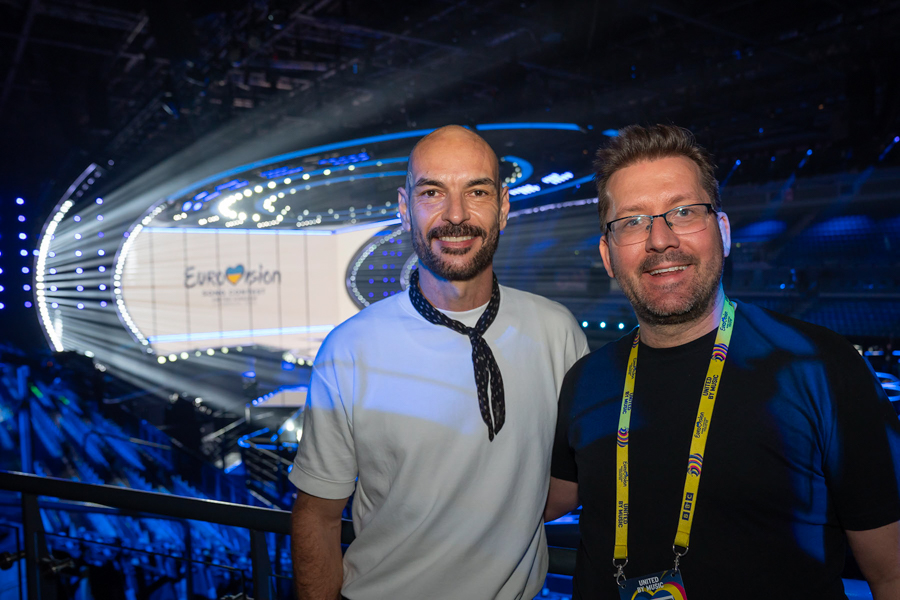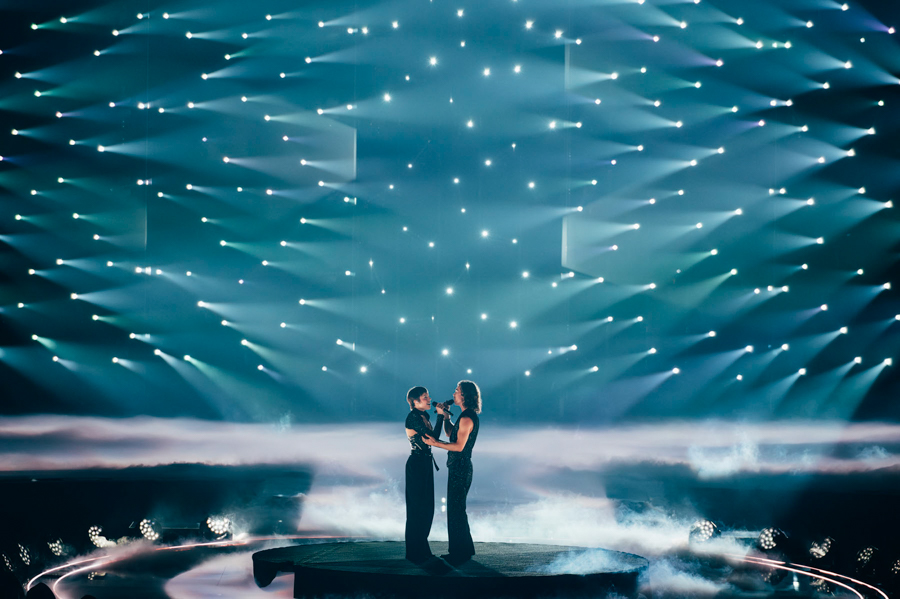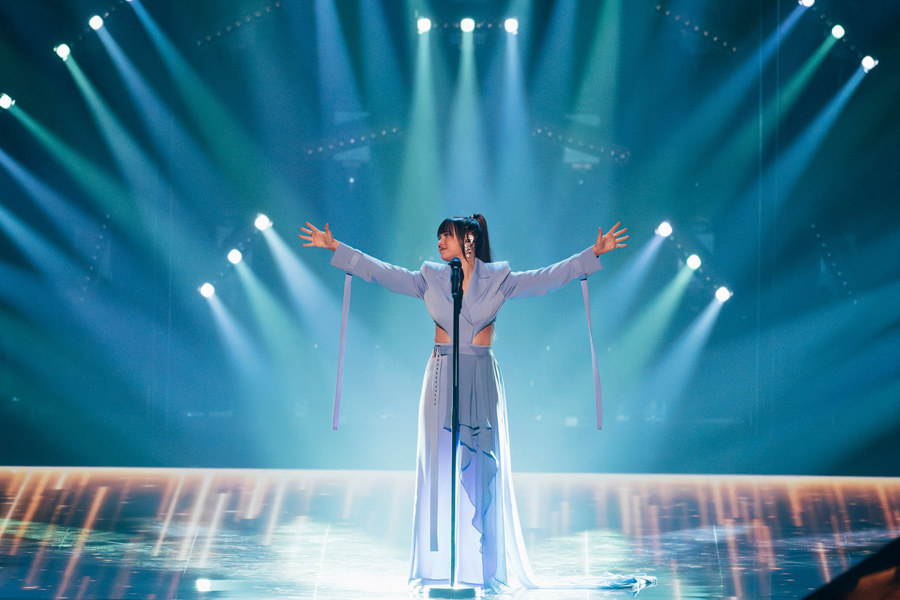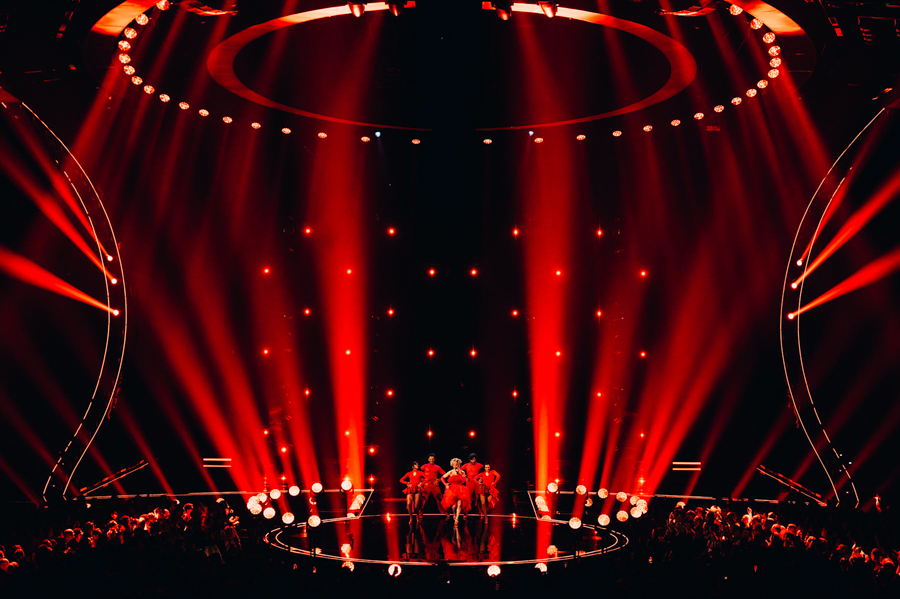Award-winning lighting designer Tim Routledge and a hugely talented team of creatives and technical specialists – working across multiple disciplines – helped deliver a dazzling, slick, streamlined and highly emotional 2023 Eurovision Song contest event at Liverpool Arena in the UK on 13th May.
All the glamour, craziness, and sheer ebullience of the 67th Eurovision Song Contest was embodied in the event that was shifted to the UK after 2022 winner Ukraine had security concerns related to the ongoing war with Russia which has raged since being invaded by its neighbour in February 2022. As the 2022 runner up, the UK stepped in and stepped up to ensure that millions of Eurovision fans worldwide could enjoy Ukraine’s party on UK soil.

Tim utilised over 600 Robe moving lights for his design which comprised approximately 2500 luminaires plus 2 kilometres of LED tape, clocking up 17,500 individual light sources when counting the individual pixel cells of the various fixtures, all supplied via lighting equipment contractor, Neg Earth Lights.
For Tim, well known for his sumptuous glossy floor and epic pop lighting designs for television, it was his first ESC. He collaborated closely with set designer Julio Himede, acclaimed for his work on major music broadcast shows like MTV’s VMAs and EMAs amongst others, also working on his first ESC.
Tim and his team created 37 unique immersive lighting environments to showcase each delegation’s songs, keeping each of these micro-shows animated, fluid and energised, curating lighting and video interactively and simultaneously. This enabled the end-goal of offering the clean, precise shots from multiple angles that resonated with camera directors Nikki Parsons, Ollie Bartlett and Richard Valentine, and translated brilliantly on the TV broadcast.
The set effectively surrounded the performance space with video, so lighting placement was challenging and had to be facilitated where there was no encroachment, whilst maintaining the architecture of the space and creating all the right moods. The results were a feat of synergy as much as technical excellence, in an infrastructure where lighting, video and scenic presentation worked seamlessly as one visual entity.
The lighting rig included a 15-way Robe RoboSpot remote follow system running with 15 out of the 66 Robe Fortes in the building, which were positioned all around the arena, offering the flexibility of picking up artists from any angle, eliminating shadows and ensuring faces looked perfect.
The Forte parameters could all be controlled via the FOH grandMA3 consoles, leaving the operators free to concentrate on following the artists. Other Robe elements included 152 x LEDBeam 150s, 84 x Paintes, 123 x Spiiders, 190 TetraXs, 12 x Robe BMFL Blades and 12 x Robe Patt2013s, a fixture that Tim invented, and that he used on this occasion to light Latvia’s performance.
A back wall of TetraXs worked brilliantly as stun-and-amaze effects for several artists. They were on the reverse side of seven LED columns making up the back wall of screen which rotated 360 degrees revealing the TetraXs, and made their presence felt during the performances of Israel, France, Finland and others. An upstage wall of Paintes was revealed when the screens were rotated at 90 degrees.
Tim’s FOH team included Ukrainian LD and programmer Zhenya Kostyra – a regular at Kyiv based rental company Alight – who worked as the overnight associate LD when on site, with James Scott as the overall lighting design associate. Lead programmer was Tom Young and the other two main programmers were Marc Nicholson and Alex Mildenhall.
Follow spots were called by Louisa Smurthwaite, and Morgan Evans worked with Tim and Tom during the pre-viz period which included four weeks at Neg Earth’s studio ahead of the get-in in Liverpool, when the process continued onsite as each delegation’s lighting looks evolved and were finessed.
Seven students on stage and lighting design and technical courses at two locally based academies – the Liverpool Institute of Performing Arts (LIPA) and Cheshire College – had the opportunity of working on Tim’s crew for the duration the event was on-site at the Arena. Five were RoboSpot operators and the other two were lighting technicians, all recruited via Robe UK’s NRG (Next Robe Generation) programme.
Additionally, Tim’s team co-ordinated with four vision engineers in the truck, and at the centre of ensuring all things lighting ran as smoothly as the surface of the best polished Eurovision glitterball, was gaffer Keith Duncan.
Tim elucidates that around 79,000 lighting cues were programmed into the consoles over the course of the three live broadcast shows, which included two televised semi-finals from which the last songs from the 37 participating countries were chosen … and went forward to the final. The finale line up comprised 26 stonking pop anthems from 26 countries covering a diversity of genres from thrash metal to hip hop!
With 50-second set changeovers, all delegations with their own creative directors and demands and the sheer intensity of creating that many individual performances, several very complex, in a short space of time, challenges abounded … and everyone delivered a superlative show.
Tim was “thrilled” to be involved, even admitting that designing a Eurovision final event was one of his professional bucket list items! He is also the first to credit the “massive” teamwork that made it all happen, together with the fusion of skills, experience, personalities, and camaraderie of all involved. “It is the most joyous show I have worked on, with a team who just wanted to be there and give it their all, and of which Ukraine could be very proud!”
The annual glam-and-glitter-tastic pop extravaganza is one of the biggest entertainment broadcast events of the year. It was organised by the European Broadcasting Union (EBU) and host broadcaster the BBC (British Broadcasting Corporation) on behalf of UA:PBA, Ukraine’s public broadcaster.
The live shows were presented by British singer Alesha Dixon, British actress Hannah Waddington and Ukrainian singer Julia Sanina, who were joined for the final by Irish TV personality, Graham Norton.
The 2023 winner was Sweden with “Tattoo”, performed by Loreen who became only the second performer in the history of Eurovision to win twice, following her success in 2012 with another banger, “Euphoria”.
Coming a nail-biting second was Finland’s flamboyant Käärijä with “Cha Cha Cha” which stormed home with the biggest public vote.
For more information visit the Robe lighting website













